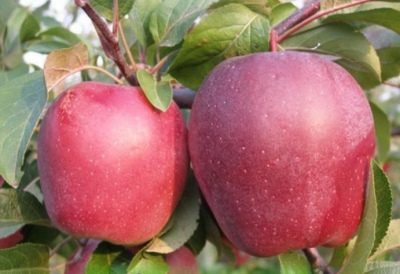
- Authors: German selection
- Taste: sweet and sour
- Scent: there is
- Fruit weight, g: 140-170
- Fruit size: average
- Yield: high
- Frequency of fruiting: annual
- Ripening terms: winter
- Removable maturity: in the III decade of September
- Keeping quality: until February, refrigerated until May
If you want to grow an apple variety with a high tasting mark on your site, then Gloucester is one of the best options. It is picky, requires little maintenance, and is available even for beginners in the field of crop production.
Breeding history of the variety
Gloucester is a German variety. It was obtained by crossing such apple trees as Red Delicious and Glockenapfel.
Description of the variety
In an adult tree, the crown is not very dense, it has a pyramidal shape. The apple tree grows up to 9 meters if the gardener does not prune in time. A small number of shoots usually leave the main trunk. All branches grow at an acute angle in relation to the trunk.
The foliage is round, dark, rich green. Small in size, dense, with many wrinkles. On one side, the surface is matte, on the other there is a fluff. The flowers show a delicate pink hue when they open. They smell great, which is why there are always so many bees around the apple tree. The tree blooms in mid-May.
Features, pros and cons
It is definitely worth mentioning the advantages and disadvantages of the variety.
Pros:
- tasters highly appreciated the taste of the variety;
- fruits can be transported over long distances;
- the variety is very frost-resistant;
- the yield is high.
Minuses:
- harvesting without pruning is difficult;
- apples are weakly attached to the cuttings, so they quickly fall off.
Ripening and fruiting
The variety, which is winter in terms of ripening, reaches maturity only in the third decade of September. Bears fruit every year.
Growing regions
The South of Russia and the North Caucasus are considered the best regions for growing this apple tree variety.
Yield
It is a high-yielding variety. With proper agricultural technology, you can collect from 42 to 75 kg of fruits.
Fruits and their taste
Gloucester fruit is eaten fresh. They have an attractive pink-red coloration with a slight blush. The fruits have a rounded-conical shape, the mass of apples is from 140 to 170 grams. The skin has a glossy sheen, it is smooth, of medium thickness. There are multiple dots under the skin that are clearly visible.
The taste, like most apples, is sweet, but slightly sour. The aroma is wonderful, pronounced. After picking, apples can lie in a cool place until February, and if the temperature is lowered, then until May.

Growing features
Pruning is an integral part of apple tree care. The procedure must be carried out to control the shape and size of the plant. Dead, damaged or diseased branches need to be pruned from time to time. In addition, shoots that cross each other or grow inward towards the main trunk are removed. The best times for pruning are late winter and summer.
Watering the trees regularly, but not watering them. Apple trees love moist, well-drained soil, but waterlogging can lead to root rot.Use trellises or posts to support the plant during fruiting.
Mulching can help preserve moisture and soil temperature, but the layer under the tree must be removed in the fall after harvest to prevent mice from nesting in it and destroying the bark.



Pollination
The described variety is only partially self-fertile, therefore, for its cultivation and pollination, it is necessary to plant pollinators within 30 meters. These include other varieties such as Spartan, Gala, and Jonathan.
Top dressing
Fertilize the young apple tree with a balanced liquid fertilizer every 2 weeks during the growing season. Apply any complex organic and mineral fertilizers when the tree gets older. Start cutting back in late fall and stop feeding in winter.
Trees can be stressed after harvest, so post-harvest fertilization is also necessary. It is very important that when they are introduced into the soil, moisture also enters the soil. Fertilizing the soil should be avoided during warm and dry summers. The amount of applied minerals should be determined using soil and leaf tissue analysis.
Often, gardeners use the fertigation method, where fertilizers are mixed with water in a drip irrigation system. A very effective method.

Frost resistance
Winter-hardy variety. Shelter is required only for very young trees. The trunk around the apple tree is covered with mulch.

Diseases and pests
Aphids, moths, apple weevil, scab, powdery mildew, brown rot - these are the problems that the gardener has to face. If the described variety has a high resistance to fungal diseases, then it is easily affected by scab. Apple scab is a fungal infection that is caused by spores of a semi-biotrophic fungus carried by wind, rain, or animal bodies until they come into contact with your plant.
If the apple tree is sick, then they do not wait for the infection to worsen, and immediately take action. Spray the apple tree with liquid copper sulfate and a sulfur-based fungicide, immediately after the first symptoms appear.Continue to repeat the process at intervals of 7 (wet weather) or 10 (dry weather) days until the apples are ready to harvest. It is also recommended to rake the leaves that fall off the tree and burn them to prevent further spread of the spores.

The apple tree is a popular fruit crop among gardeners. It can be found in many summer cottages. But at the same time, such trees are often affected by various diseases. It is very important to recognize the disease in time and carry out the necessary procedures for a speedy recovery. Otherwise, the fruits will be spoiled, and the tree itself may die altogether.












































































